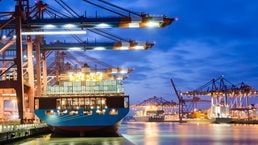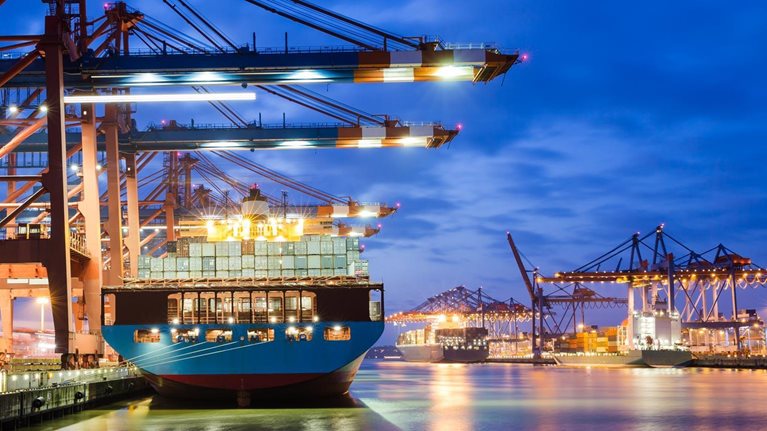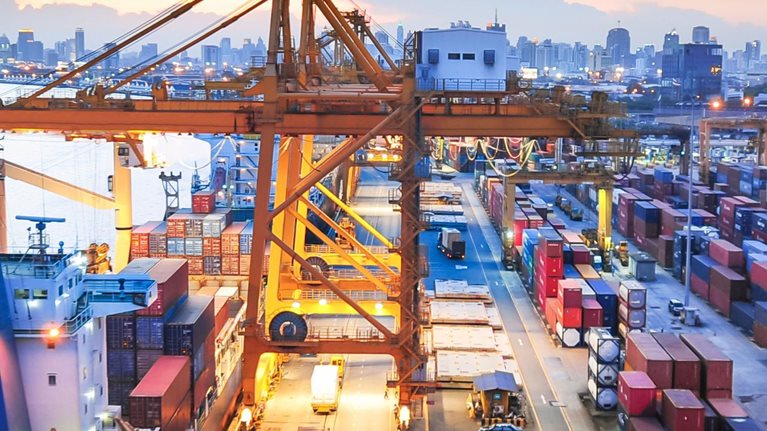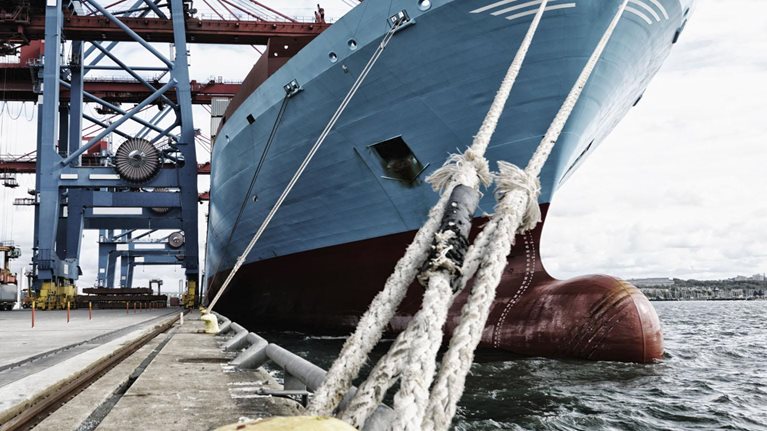When you talk about the health of the port and shipping sector, you start with volumes and growth. Growth is important to all sectors—but especially to this one, since so much of the total cost of production is tied up in large, expensive fixed assets. Volume growth leads to many good things: mounting revenues, high asset utilization, approvals for new investments, good pricing behavior among competitors, and win-win relations between management and labor. Bad things happen when you don’t have growth.
Stay current on your favorite topics
Historically, the sector has done pretty well—with short-term cyclicality but consistent expansion over time. In the 1950s, trade started to grow faster than GDP, and in the 1980s it really took off, growing twice as fast as GDP and sometimes faster. What we see now is different. Demand isn’t increasing as fast as it was. GDP growth has slowed down, while the trade multiple—the ratio between GDP and trade—has fallen to one.
Economists debate whether these numbers embody the new normal or just the down phase of the latest cycle (which would suggest that the growth we saw for 30 years will eventually come back). The short answer: we don’t know. It would be understandable if the shock of the most recent crisis—the biggest downturn since the Great Depression—required an unusually long recovery. But don’t count on an easy return to the days when trade increased 2.0 to almost 3.5 times faster than GDP.
For one thing, the idea that the trade ratio has always been at least two isn’t really correct. It was better than that in the 1990s but stood at 1.5 for much of the past century—and was 0.5 for a lot of the 1920s, ’30s, and ’40s (exhibit).

Further, the events that propelled the recent boom cycle were exceptional. China’s reemergence was a unique event. A big global trade agreement signed in 1986 reduced tariffs across 123 countries by some 40 percent. The expansion of global communications facilitated the unprecedented globalization of supply chains. An extraordinary turn of events would be needed to get the trade ratio back above two.
Would you like to learn more about our Travel, Logistics & Transport Infrastructure Practice?
Of course, the slowdown in growth isn’t good for the sector. Returns have also dropped as a result of falling utilization levels, increased competition, and larger capital expenditures as carriers, first in Asia and Europe but now in the Americas too, buy more and bigger vessels. This isn’t the most obvious thing to do at a time of slowing demand, but because the new, larger ships have such great economics, the math—for individual companies—does suggest that it makes sense to invest in them. To get the money for these vessels, carriers launch efficiency efforts that reduce staffing levels in customer service and support, and exit what they consider ancillary parts of the business (for instance, chassis). They bring together the volumes needed to fill the larger vessels by joining alliances to share services.
Ports, terminals, and port-service firms have responded to lower growth by investing in cranes, dredging equipment, and other things to accommodate the larger vessels. Some of the investments replace older assets, but mostly they increase capacity—or supply. Again, this makes sense for individual players but not for a sector facing softer demand. These port players have also taken on a lot of complexity to accommodate changes in the sector. As a result, port calls are clunkier, customers have different requirements for different sailings of the same service, and the entire process of managing chassis and equipment gets far more complicated.
Not surprisingly, such moves do very little, on balance, to improve the sector’s economics. Fuel savings at sea are real—but they get passed on to shippers in the form of price breaks. Other costs just move from one kind of sector participant to another. And now, both the carriers and the port players suffer from moderate to dramatic oversupply, which makes for tougher negotiations and worsening economics.
Complications
What are beneficial cargo owners (BCOs) and shippers feeling and doing while all of this happens?
Complication 1: Shippers are unhappy with the service they get
We spent time last year talking with all sorts of downstream participants in the shipping community, such as BCOs, forwarders, and groups like the National Retail Foundation. Thanks to rate reductions by ocean-freight providers, North American shippers enjoyed about $23 billion in savings from 2010 to 2015. Despite this, they aren’t happy; the service they receive frustrates them. Many said they would be willing to pay more in return for improvements in, for example, the availability of equipment, reliability, transparency, and communication. Some interviewees went out of their way to tell us that the carriers—not they themselves—had driven down rates.
Second, although ocean-freight customers have always been told that service disruptions stem from labor strikes, driver shortages, and the like, they are now beginning to believe that the problems also result from conscious decisions made by ocean-freight providers and port operators. This is, of course, a concern.
Third, the biggest theme (or felt need) of shippers is the importance of improved transparency and communication. The one thing we did not hear a lot of complaints about was scheduled transit times. Of course, transit times are important—especially for some industries and commodities. But we heard many more requests for reliable delivery dates and better transparency when things go wrong.
Complication 2: Shippers are starting to act
In response to these complaints, shippers are making very significant investments. New players in the global transport and logistics space hope to improve cargo-monitoring services; one of them, Traxens, has already won backing from the Mediterranean Shipping Company and CMA CGM. Meanwhile, Amazon is investing massively in its own logistics network. It has an ocean-freight-forwarder license in China and just made another long-term lease commitment for planes. It has also actively bid on ports and recently looked to buy an airport in Germany.
Why is Amazon making all these investments? Of course, it wants its logistics costs to fall—removing the intermediary does have some value. But the logistics and freight markets have lots of excess capacity, so Amazon’s principal motive probably isn’t costs or leverage over suppliers. If the company’s only goal was to lower the rates it pays for ocean transport or air freight, it could negotiate with the carriers. In fact, Amazon could probably get just about any rate it wanted in return for a long-term volume commitment.
We believe that the company has more important things on its mind than costs. We know it thinks that logistics and supply chains are strategic elements of the value proposition it offers to customers and therefore feels the need to be the world’s best in that space. It also sees the huge waste of time and money at the intersection of all the different elements—and believes it could eliminate that waste if it had more control over the end-to-end chain.
What does all this mean?
Such realities discredit the fallacy that too many in this sector have accepted: the idea that all customers care about is the rate they pay—the price per container. I have heard countless executives complain that shippers will desert them for $5 to $10 a box, so that they need to do everything possible to lower their costs. This used to be true (and in some pockets of the business it still is), but the way customers look at costs is changing.
I have been in global logistics for nearly 20 years—in rail freight, air cargo, trucking, and logistics (see sidebar “How I got hooked on ports and shipping”). In the early days, many sales executives told me that the challenge of selling transportation was that nobody in the C-suite cared a fig about it. These sales executives, who were talking to logistics buyers with no responsibility for anything outside their control, could never get anyone to think about service. That is no longer true.
Costs are still very important, but they no longer mean simple things like a carrier’s freight rate per container or a terminal’s rate per lift. All of the transport customers I speak with complain about the dreaded procurement departments that manage complex requests for proposals and bidding events. Every one of these best-practice procurement efforts involves scrutinizing end-to-end costs to understand the total expense of any supply-chain solution. Not all shippers can play this game, but it is becoming the norm.
Opportunities
As a result, we’re seeing organizations in the port space—authorities, operators, service providers, third-party logistics companies, and forwarders—doing more and more to improve the end-to-end supply chain. That’s what today’s customer wants, and that’s what helps freight lines and ports attract new cargo. We see three themes, or areas for improvement.
Theme 1: Improving the customer experience
When we spoke with shippers, most of what we heard concerned the quality of service. The pressing issues were reliability or consistency and the level of transparency and communication when things go wrong. Everyone is investing in this area.
To develop a truly differentiated service, liners and ports that make such investments should think about two dimensions. The first is ways to increase end-to-end transparency. Can you extend into rail? Can you extend into trucks? For inspiration, look to Antwerp. All the sector participants in and around that port joined together to establish a data-sharing company and build a full digital ecosystem. They plan to have complete, end-to-end sharing of data—from ocean to pilot to berth to yard to gate to rail to truck to BCO and back again.
The second area to think about is the use of big data and advanced analytics to make predictions and guidance more reliable. One of the problems in tracking containers, for example, is that information is only as good as what trucking companies or carriers supply.

The alliance shuffle and consolidation: Implications for shippers
In the past, predicting the arrival of vessels in port was difficult—it mostly involved asking carriers when they thought their ships would come in, and too often they simply relayed whatever they heard from their captains. This process is often inaccurate: the average difference between a captain’s estimate and the actual time of arrival was 13 hours. But new tools combine publicly available GPS data on the current position of vessels with the latest machine-learning techniques. Such tools can estimate the deviation between the current and scheduled position of a ship and therefore provide a better estimated time of arrival for any port on its route.
Obviously, many other things could improve the customer experience—new crane technology, better communication, collaboration with stowage plans, and so forth. But don’t overlook transparency and communication, the biggest felt need among shippers.
Theme 2: Commercial excellence
Serving the needs of existing customers is one thing, finding new ones quite another. So is getting your customers to pay for the premium services you provide, which isn’t easy. I see three opportunities.
-
Micromarket planning. Slowing GDP numbers and falling trade multiples are only averages. Nobody competes in an average market; what’s important is the actual trade growth and the actual trade multiple for the industry you support. Those numbers vary greatly by industry, by commodity, by origin, and by destination. The best B2B companies work hard to canvass the market for areas of growth. When sales teams shift focus to that goal, we see 20 percent increases in port volumes, for example.
-
Joint sales and marketing efforts. Shippers no longer care much about the individual prices of the individual components of a logistics solution. Their real preoccupation is the quality of the end-to-end solutions that get products where they need to go. Yet most sales calls in the port-and-shipping sector still involve one-on-one interactions: shippers talking to carriers, carriers to terminals, terminals to ports. These efforts must become more integrated—which is already starting to happen. We’ll see a lot more of this in the years to come.
-
Tiered pricing. Last year, some of my colleagues wrote an article explaining the opportunities to use pricing to increase productivity and remove waste in the joint supply chain.1 The basic premise was that current pricing mechanisms in the port-and-shipping sector are too simplistic. In general, there’s no additional expense for peak berthing windows. Carriers don’t pay ports more for poor stowage plans. There’s no explicit extra charge for larger vessels, which disrupt schedules because they take longer to pilot, berth, load, and unload. The full adoption of a more robust pricing scheme could help the sector eliminate $2 billion to $3 billion of waste by putting the responsibility for it in the hands of the guilty parties.
Some of these ideas are hard to implement. However, the hard part isn’t the math but rather getting all the different stakeholders to work together. Ports are seeing a real, positive impact when they start to implement these kinds of ideas: for example, increasing the utilization of machinery by 3 to 5 percent when they charge different prices for day and night operations and by an additional 12 to 15 percent when they introduce fines for unattended truck windows.
Theme 3: End-to-end collaboration
One of the trickiest things about this sector is the need to work across so many stakeholders. But that necessity provides not only challenges but also enormous opportunities. One recent example of what I have in mind involves the Greater Toronto Airports Authority (GTAA), which is working to develop an integrated strategy to meet the growing demand for air travel in the area. Seaports differ from airports, of course, but parallels abound—particularly the need for cooperation among stakeholders.
Every time the authority tried to develop a strategy, it ran into roadblocks—some constituency or other wasn’t aligned with the plan and would offer an alternative that eroded its force and value. The GTAA therefore decided to initiate a major effort, working with all the other stakeholders to form a strategy for southern Ontario.
During an 18-month effort, GTAA built a robust fact base about the area’s current and future economic, demographic, and ground-transportation needs to estimate the sources of aviation demand. The authority spent months sharing its fact base with stakeholders throughout the region, taking feedback from them and building on their perspectives. Working with regional airports, the provincial and federal governments, and industry experts, GTAA then led a process to develop an integrated strategy to accommodate the expected growth. There is still much to do, but the stakeholders now work as a team around an aligned set of facts and a shared perspective on what’s needed.
The challenges are significant, but so are the opportunities and potential. Capturing your fair share of them will require new thinking. It will require investments and trade-offs. Most important, it will require solutions that cross functional lines, company lines, public-versus-private lines, and industry-versus-environment lines. Let’s start crossing them now.


